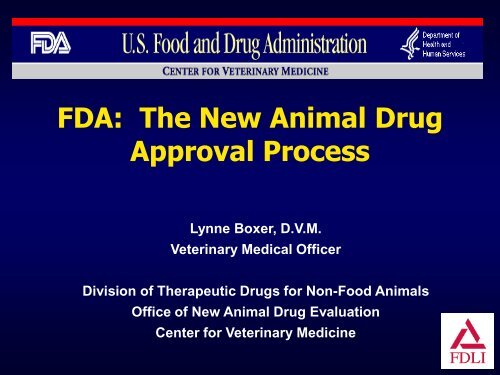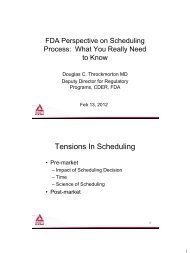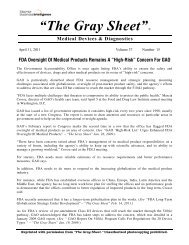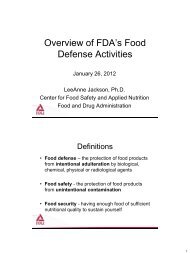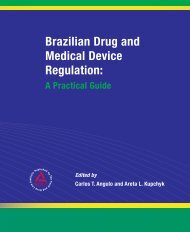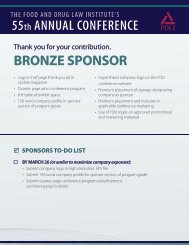FDA: The New Animal Drug Approval Process
FDA: The New Animal Drug Approval Process
FDA: The New Animal Drug Approval Process
You also want an ePaper? Increase the reach of your titles
YUMPU automatically turns print PDFs into web optimized ePapers that Google loves.
<strong>FDA</strong>: <strong>The</strong> <strong>New</strong> <strong>Animal</strong> <strong>Drug</strong><strong>Approval</strong> <strong>Process</strong>Lynne Boxer, D.V.M.Veterinary Medical OfficerDivision of <strong>The</strong>rapeutic <strong>Drug</strong>s for Non-Food <strong>Animal</strong>sOffice of <strong>New</strong> <strong>Animal</strong> <strong>Drug</strong> EvaluationCenter for Veterinary Medicine
What is the <strong>FDA</strong>?<strong>The</strong> Food and <strong>Drug</strong> Administration(<strong>FDA</strong>) is a federal agency within theDepartment of Health and HumanServices.
What does <strong>FDA</strong> regulate?CFSANCVMCDERNCTR<strong>FDA</strong>CDRHORACBERCTP
What is CVM?<strong>The</strong> Center for Veterinary Medicine– Consumer protection organization, fostering publicand animal health– Authority derived from the Federal Food, <strong>Drug</strong>, andCosmetic Act– CVM is responsible for assuring that animal drugsand medicated feeds are safe and effective andthat food from treated animals is safe to eat.
What is a <strong>Drug</strong>?• Under the Act, the term “drug” means…articles intended for use in the diagnosis,cure, mitigation, treatment, or prevention ofdisease in man or other animals; and articles(other than food) intended to affect thestructure or any function of the body of manor other animals …21 U.S.C. 321 Sec. 210(g)(1)• <strong>The</strong>se stem cell products are drugs
What about biologics?• <strong>The</strong> regulations define biologics as all viruses,serums, toxins … which are intended for use in thetreatment of animals and which act primarilythrough the direct stimulation, supplementation,enhancement, or modulation of the immunesystem or immune response 9CFR101.2• Veterinary biologics are regulated by USDA
What drugs can be legallymarketed?• <strong>FDA</strong> approved products– NADA-new animal drug application (pioneer)– ANADA-abbreviated NADA (generic)– CNADA-conditionally approved NADA– Indexed minor species products
How do I market a product?• Work with CVM• Contact CVM to determine the regulatorystatus of your product• If your product is a drug, begin the approvalprocess– Work together with CVM to share informationand determine path to approval
ADUFA Fees• <strong>Animal</strong> <strong>Drug</strong> User Fees are fees paid bysponsors to support the review of animaldrugs• Waivers: Apply before opening INAD
Pre-INAD• Prior to opening an Investigational <strong>New</strong><strong>Animal</strong> <strong>Drug</strong> (INAD) file• Pre-INAD meetings for innovative products– Inform CVM about the product– Learn about the approval process• Pilot studies in laboratory research animals(non-client owned animals)– Must comply with 21 CFR 511.1(a)
INAD• Open the INAD– Provide as much product information to CVMas possible• Product characterization– Can submit when you open the INAD• Request a meeting to discuss productcharacterization and development plan
INAD• Pilot studies in client owned animals– Must comply with 21 CFR 511.1(b)– INAD exemption allows shipment ofinvestigational drug in interstate commerce• Sponsor responsibilities under the INAD– Labeling, data collection, records, drugaccountability, animal disposition, investigatorqualifications
Presubmission Conference• After sufficientproductcharacterization• Work together todetermine the typesof studies that will beused to supportsafety, effectiveness,and manufacturing
Protocols• May be submitted to CVM for review• Safety, effectiveness, manufacturing• CVM concurrence means we fundamentallyagree with the study design
Major Technical Sections• Safety– Target animal, special studies• Effectiveness– Substantial evidence, field study, conditions of use• Manufacturing– Identity, strength, quality, purity• Human Food Safety• Environmental
Minor Technical Sections• Labeling• All Other Information• (FOI)
Administrative NADA• Administrative <strong>New</strong> <strong>Animal</strong> <strong>Drug</strong> Application(NADA)• Administrative application submitted after alltechnical sections are completed• Completion of Administrative NADA = <strong>FDA</strong>approved product• Non-administrative NADA
Sponsor References• CVM websitewww.fda.gov/<strong>Animal</strong>Veterinary/default.htm• FOI summaries• CVM guidances• <strong>New</strong> animal drug regulations– 21 CFR 511 and 21 CFR 514• CBER regulations and guidances
Contact InformationLynne Boxer, DVMlynn.boxer@fda.hhs.gov(240) 276-8321


